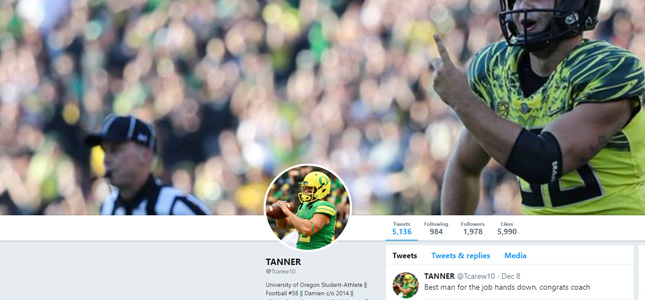
It took mere hours for Joey Casselberry’s life to be turned upside down after he made a vulgar Twitter post referencing Little League star Mo’ne Davis. Casselberry broke records in high school, and as the starting first baseman for Bloomsburg University in Pennsylvania, appeared to have a promising career ahead of him. Instead, Casselberry discovered what many athletes discover all too late: the unforgiving memory of the internet.
When Bloomsburg University became aware of the tweet, they quickly removed him from the team. Although Davis attempted to intervene on Casselbery’s behalf, the university refused to reinstate him. Today, a Google search of his name yields thousands of unflattering results—the first page alone features articles saying he “ruined his life” and called him a “slimeball.”
Kelli Matthews, senior instructor of public relations in the School of Journalism and Communications, works hard to prevent a similar occurrence at the University of Oregon. Every summer she teaches a one-credit class on social media usage, which nearly every freshman student athlete takes.
“We do talk about people who have made big mistakes and what the consequences were, but I don't want to just scare them,” she said. “I want them to realize that they have the ability to really tell a powerful and compelling story and establish a positive and focused personal brand that will serve them not just as a student athlete, but in their professional life off the field.”
After college, thoughtless comments on the Internet carry the potential to reduce an athlete’s chances of being drafted into professional leagues. Those who opt not to pursue a career playing professionally might lose jobs, internships, and other opportunities.
Universities are well aware of this, but also of the risk to their own reputations. Some have taken extreme measures, employing companies such as Fieldhouse Media and Varsity Monitor to oversee their students’ accounts, which has been criticized as a breach of privacy. For thousands of dollars each year, these companies use searches for words like “free” (which could indicate a player has received a gift in violation of NCAA rules). Other coaches forbid their students from using social media sites at all.
But the University of Oregon chooses instead to focus on prevention education.The class, which Matthews designed herself, serves as an introduction to college life. Mental health, resumes, and study strategies are included along with guidelines for responsible social media use. Coaches discuss team policies, which can vary between sports; some require their players to add them on platforms such as Snapchat and Instagram. The class also covers NCAA regulations about athletes’ social media use, which are not always obvious; for example, it is a violation to share anything online related to a teammate’s injury.
Matthews focuses on the positive: students, for example, are taught how to take quality photos on Iphones to lend a sense of professionalism to their feeds. Simple photography techniques, like the rule of thirds or leading lines, are easy ways to upgrade photo quality. Because social media content is accessible by anyone, student athletes are advised to keep their message upbeat and focused. Good grammar and careful fact checking also contribute to a polished account.
“It was interesting hearing some of the bad stories,” said Tanner Carew (@tcarew10), senior long snapper for the Las Vegas Bowl-bound football team. “It was funny because you don't know the people in there because you're a freshman, and then she puts everyone on blast, putting up pictures and videos you've posted in the past, good and bad examples. It's a good icebreaker as a freshman to meet everybody…. The feeling you got in that class, being afraid that she was going to put you up on the board—that's how you should think all the time, that people are going to see that. You've got to be careful what you've got to put online.”
The other side of social media is more positive: athletes have enormous platforms, from which they can tell a certain story about themselves to land jobs, internships, and other opportunities. In August, some members of the football team created a twitter account called Oregon Specialists (@oregonspecs), which uses humor to highlight some of the Ducks’ underrepresented athletes. In has accumulated more than 1,000 followers since its inception. One post captioned a photo of kicker Aidan Schneider sleeping on the floor, while the golden belt awarded to the special teams player of the week was tucked into bed: “Belt gets the bed… always.” Other posts tease rival schools, caption photos of napping coaches, or feature specialists of the week.
The account proves the positive potential of social media as a promotional platform, rather than a career-ending mistake. With mindful use, social media becomes a powerful professional tool.
“The feeling you got in that class, being afraid that she was going to put you up on the board—that's how you should think all the time, that people are going to see that,” said Carew. “You've got to be careful what you put online.”
- Abby Keep, Class of '19
University of Oregon student